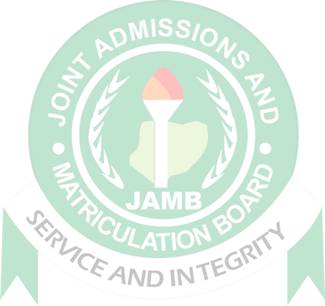
Biology
Paper 1 | Objectives | 40 Questions
JAMB Exam
Year: 2020
Level: SHS
Time:
Type: Question Paper
Answers provided
FREE
No description provided
Feedbacks
This paper is yet to be rated

Paper 1 | Objectives | 40 Questions
JAMB Exam
Year: 2020
Level: SHS
Time:
Type: Question Paper
Answers provided
No description provided
This paper is yet to be rated
These are the three things to do in test preparation for higher grades and excellent performance.
There's no secret to passing WAEC or BECE apart from the merit of hard work and adequate preparation
Get free IT courses with certificates online for your skills upgrade in this era of Covid-19.
| # | Question | Ans |
|---|---|---|
| 1. |
The hormone which regulates the amount of glucose in the blood is called? A. Adrenalin B. Auxin C. Insulin D. Thyroxine
Show Content
Detailed SolutionInsulin helps control blood glucose levels by signaling the liver and muscle and fat cells to take in glucose from the blood.There is an explanation video available below. |
|
| 2. |
Deamination occurs in the? A. Kidney B. Pancreas C. Spleen D. Liver
Show Content
Detailed SolutionDeamination is used to break down amino acids for energy, and occurs primarily in the liver.There is an explanation video available below. |
|
| 3. |
In an agricultural ecosystem, the biotic component consist of A. crops, pests and beneficial insects B. crops, temperature and humidity C. pests, beneficial insects and water D. crops, water and soil
Show Content
Detailed SolutionThe living components of an ecosystem are called the biotic components, option A has all living components.There is an explanation video available below. |
|
| 4. |
Epiphytes growing on the branches of trees provide an example of the relationship known as? A. parasitism B. commensalism C. saprophytism D. holophytism
Show Content
Detailed SolutionCommensalism is a type of symbiosis, specifically, a biological relationship in which one specie benefits from an interaction, while the host species is neither positively or negatively affected to any tangible degree.There is an explanation video available below. |
|
| 5. |
The hypha of rhizopus is said to be non-septate because it A. does not contain chloropyll B. has no cross wall C. is vacuoled D. stores oil globus
Show Content
Detailed SolutionHyphae that have walls between the cells are called septate hyphae; hyphae that lack walls and cell membranes between the cells are called nonseptate or coenocytic hyphae)There is an explanation video available below. |
|
| 6. |
The function of ribosome in cells is A. protein synthesis B. starch synthesis C. transport of material D. lipid storage
Show Content
Detailed SolutionA ribosome is a cell organelle. It functions as a micro-machine for making proteins.There is an explanation video available below. |
|
| 7. |
In which of the following does external fertilization take place? A. toad B. lizard C. bird D. cockroach
Show Content
Detailed SolutionExternal fertilization is a mode of reproduction in which a male organism's sperm fertilizes a female organism's egg outside of the female's body. Many fish, amphibians, and other sexual aquatic animals use external fertilization (the exceptions are aquatic mammals, sharks, and some other special types of fish).There is an explanation video available below. |
|
| 8. |
The villus in the small intestine is significant because A. Increases the surface area for absorption B. increases the surface area for digestion C. assists in mixing digested food D. assists in filtering undigested food
Show Content
Detailed SolutionVillis are specialized for absorption in the small intestine as they have a thin wall, one cell thick, which enables a shorter diffusion path.There is an explanation video available below. |
Preview displays only 8 out of the 40 Questions